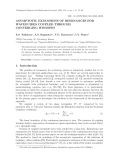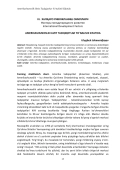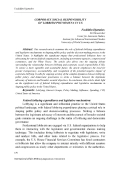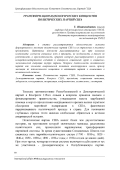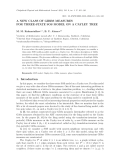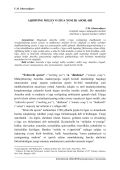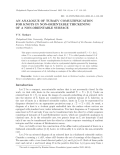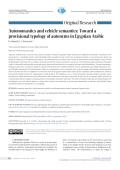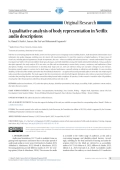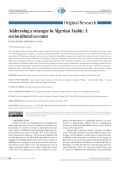Two-dimensional waveguides coupled through small windows are considered. First terms of the asymptotic expansion of resonances are obtained and studied for the case when the distance between the windows decreases. Method of matching of the asymptotic expansions of solutions of boundary value problems is used.
Maqolaning maqsadi Amerika tadqiqotlarining tarixiy konteksti va zamonaviy dolzarbligini taqdim etishdir. Fanning asosiy paradigmalari va ularning ijtimoiy va madaniy kontekstdagi ahamiyati o‘rganiladi. Amerika tadqiqotlarining mustamlaka davrida paydo bo‘lganidan XX asr o‘rtalarida to‘liq ilmiy ixtisosga aylanishigacha bo‘lgan evolyutsiyasi va uning baynalmilalshuvini ko‘rib chiqiladi. Amerika tadqiqotlarining mavzusi, manbalari, geografik asoslari va usullari, shuningdek, ushbu sohadagi ba’zi zamonaviy tendentsiyalar tahlil qilinadi.
We have investigated the correctness of a linear inverse problem for a three-dimensional second kind, second order mixed-type equation in an unbounded parallelepiped. The existence and uniqueness theorems for a generalized solution to a linear inverse problem for the equation with a semi-nonlocal boundary condition are proved in a certain class of integrable functions. The ε-regularization, a priori estimates, approximation sequences, and Fourier transform methods are applied.
Ushbu tadqiqot maqolasi federal lobbichilik xarajatlari va Qonunchilik mexanizmlarining davlat siyosati va Qo’shma Shtatlarda qaror qabul qilish jarayonini shakllantirishdagi rolini o’rganadi. Bu professional lobbistlarning turli federal tashkilotlarni, shu jumladan davlat idoralari, Kongress qo’mitalari va oq uyni himoya qilishga sezilarli ta’sirini ta’kidlaydi. Maqolada, shuningdek, lobbichilik va korporativ ijtimoiy javobgarlik (KSS) o’rtasidagi munosabatlar atrofidagi doimiy munozaralar ko’rib chiqiladi. Yanada adolatli va barqaror kelajakni ta’minlash uchun maqolada shaffoflik, hisobdorlik va korporativ lobbichilikning mumkin bo’lgan salbiy ta’sirini tan olish zarurligi ta’kidlangan. U lobbichilik, davlat siyosati va demokratik boshqaruv o’rtasidagi murakkab dinamikani doimiy ravishda tekshirishni talab qiladi, bu manfaatlarni qonuniy himoya qilish va kengroq ijtimoiy maqsadlar o’rtasida muvozanatni saqlashga imkon beradi. Xulosa qilib aytganda, ushbu maqola qo’shma Shtatlarda davlat siyosatini shakllantirishda federal lobbichilik xarajatlari va Qonunchilik mexanizmlarining muhim rolini yoritib beradi.
maqolada mafkuraviy jihatlar ko’rib chiqiladi AQSh siyosiy partiyalarining shakllanishi va evolyutsiyasi va ularning prezidentlar siyosatida aks etishi. Partiya mafkuralari uchta asosiy tarkibiy qism sifatida qaraladi: mantiqiy bog’liq g’oyalar va printsiplar, ularning xususiyatlari, shuningdek ularning barqarorligi va uzluksizligi, ularning tabiati ijtimoiy guruhlarning aniq tarixiy voqealari va manfaatlari va mamlakat ichidagi ijtimoiy-iqtisodiy vaziyat doirasida ko’rib chiqiladi. Siyosiy partiyalar faoliyati masalalari Amerika siyosatining elementi sifatida ularning mafkuraviy tushunchalari evolyutsiyasi va partiyalarning siyosiy tizimdagi o’zgarishlarga moslashishi prizmasi orqali tahlil qilinadi.
The phase transition phenomenon is one of the central problems of statistical mechanics. It occurs when the model possesses multiple Gibbs measures. In this paper, we consider a three-state SOS (solid-on-solid) model on a Cayley tree. We reduce description of Gibbs measures to solving of a non-linear functional equation, each solution of which corresponds to a Gibbs measure. We give some sufficiency conditions on the existence of multiple Gibbs measures for the model. We give a review of some known (translation-invariant, periodic, non-periodic) Gibbs measures of the model and compare them with our new measures. We show that the Gibbs measures found in the paper differ from the known Gibbs measures, i. e, we show that these measures are new.
Ushbu maqolada zamonaviy axborot-kommunikatsiya texnologiyalari rivojlanishining turli tashqi va ichki omillari ta’siri ostida rivojlanayotgan axborot xavfsizligi kontseptsiyasini aniqlash masalalari ko’rib chiqiladi. Ushbu maqolaning maqsadi “axborot xavfsizligi” tushunchasining asosiy jihatlarini uning shakllanishi va rivojlanishining zamonaviy belgilari asosida aniqlash, shuningdek, axborot xavfsizligini ta’minlash muammosining asosiy tarkibiy qismlarini aniqlashdan iborat. Milliy va xalqaro miqyosda axborot xavfsizligini ta’minlashning asosiy jihatlarini aniqlash asosida, axborot infratuzilmasi va AKTning zamonaviy rivojlanishini hisobga olgan holda, axborot xavfsizligi tushunchasining zamonaviy ta’rifi taklif etiladi.
Maqolada Amerika milliy o‘ziga xosligining shakllanishi va rivojlanishining asosiy siyosiy va mafkuraviy omillari ko‘rib chiqiladi va milliy xarakter shakllanishining asosiy o‘ziga xos xususiyatlari tahlil qilinadi. Mamlakat fuqarolarining o‘zo‘ zini identifikatsiya qilish shakllari va milliy o‘ziga xoslik haqidagi fikrlarning xilma-xilligi, AQShning milliy o‘ziga xosligi nima, u nima bo‘lishi mumkin va nima bo‘lishi kerakligi, etnik, irqiy, diniy va lingvistik omillarning xilma-xiligi qanday qilib mamlakat birligini saqlab qolgan holda Amerika jamiyatining mafkuraviy qutblanishiga olib kelishish mumkinligi masalalari ko‘rib chiqiladi.
This paper concerns pseudo-classical knots in the non-orientable manifold Σˆ = Σ × [0, 1], where Σ is a non-orientable surface and a knot K ⊂ Σˆ is called pseudo-classical if Kis orientation-preserving path in Σˆ. For this kind of knot we introduce an invariant ∆that is an analogue of Turaev comultiplication for knots in a thickened orientable surface. As its classical prototype, ∆ takes value in a polynomial algebra generated by homotopy classes of non-contractible loops on Σ, however, as a ground ring we use some subring of C instead of Z. Then we define a few homotopy, homology and polynomial invariants, which are consequences of ∆, including an analogue of the affine index polynomial.
Autonyms, a blend of auto- (car) and -nyms (names), constitute a subclass of ergonyms (object names) and a subdomain of onomastics I am prone to term ‘autonomastics’, a subdivision which is still understudied rather unstudied. No past research has investigated autonyms as novel tradenames dealers and purchasers assign to cars in automotive transactions. The onomastic facets of autonyms have received no attention from specialist linguists across or within world languages. This article aims to conduct a seminal lexical-semiotic analysis of ‘autonyms’ (car names). A lexicosemiotic analysis of autonyms in Egyptian Arabic is conducted by analysing their lexical and semiotic aspects with particular focus on onomastic and sign-based classifications. The article undertakes a typological analysis of a convenience sample of a dataset extracted from three e-platforms (Dubizzle, Youm7, and Masrawy) and validated through an interrater reliability questionnaire. The analysis draws mainly on a comprehensive but non-exhaustive state-of-the-art typology of denominata and denominating practices. Results show that car trademarks are transacted on the local Egyptian market under culture-specific tradenames which establish iconic, indexical, and symbolic relations between the representamens and their objects. The tradenames cover a myriad of autonyms denoting animals (zoonyms), insects (entomonyms), reptiles (herpetonyms), fish (ichthyonyms), birds (ornithonyms), and objects (ergonyms). It shows the role of Egyptian Arabic vernacular in communicating collective cognition of naming practices in the Egyptian automotive community. The article recommends replicating the devised typology with crosslinguistic and cross-cultural datasets to inform future research into onomastics in general and autonomastics in particular and probably inspire automobile industries to redesign their cars accordingly.
With the rise of streaming platforms like Netflix, viewers now have greater access to language and accessibility features. Audio description (AD) translates visual information into spoken language, enabling access for viewers with visual impairments. To match the experience of sighted audiences, AD must convey all visual cues, including physical appearances. Despite its importance, this area – where accessibility and inclusivity intersect – remains understudied. This paper investigates how Netflix’s AD represents different body types, physiques, and visible disabilities among able-bodied and disabled individuals. Using a qualitative descriptive approach, the study analyses AD in two series, one film, and one documentary to assess clarity, accuracy, consistency, and implications of these descriptions. Findings reveal inconsistencies in describing body shape and size, with such references being rare and often contingent on plot relevance. Descriptions typically appear in contexts tied to body image or physical performance, especially relating to athleticism and (dis)ability. In cases involving disability, AD often describes mobility aids rather than the individuals themselves – an approach that avoids potentially offensive terms but risks reinforcing the taboo around discussing disability. The study suggests that these inconsistencies stem from both linguistic limitations and a reliance on perceived relevance. It concludes that prevailing discourse and stigma around describing human bodies complicate AD practices. Further research is needed to refine AD guidelines, ensuring they reflect the perspectives of both those being described and those who rely on AD.
The use of address forms varies from culture to culture according to each society’s sociocultural values and norms. Therefore, the variations in the choice, usage, and understanding of forms of address can create communication problems. This study investigates address forms used in Algerian society between nonacquaintances in different age and gender contexts. It aims to identify the main address categories used to address a stranger and to trace the impact of sociocultural norms and values on their preferences. For this purpose, a discourse-completion task (DCT) was used to collect data from 104 Algerian respondents of different ages and genders which were analysed quantitatively and qualitatively. The results show that Algerians use a variety of address forms with kinship terms dominating, followed by religious terms. They testify that politeness in Algerian society is established by showing deference and respect to elders and at the same time demonstrating intimacy and closeness to the addressee, which is prescribed by the Qur’an. However, the choice of a term is determined by age, power, gender and distance. The findings reflect the collectivist and Islamic nature of Algerian society. The paper provides new insights into the impact of cultural factors on address forms and contributes to address research, cross-cultural pragmatics, intercultural communication and second language teaching.
